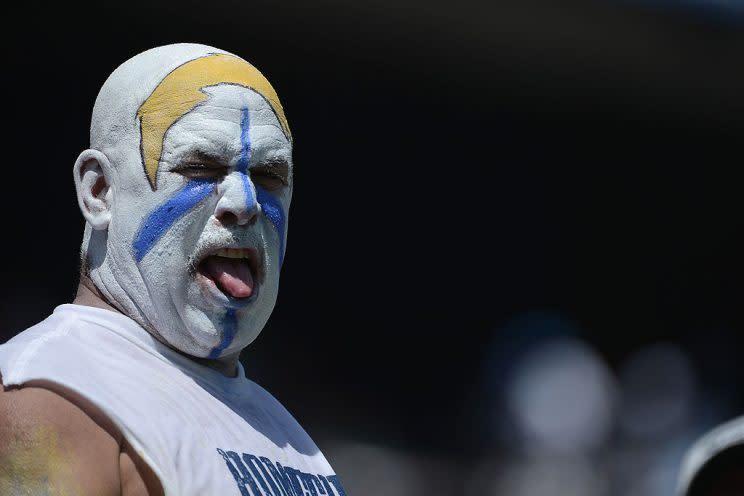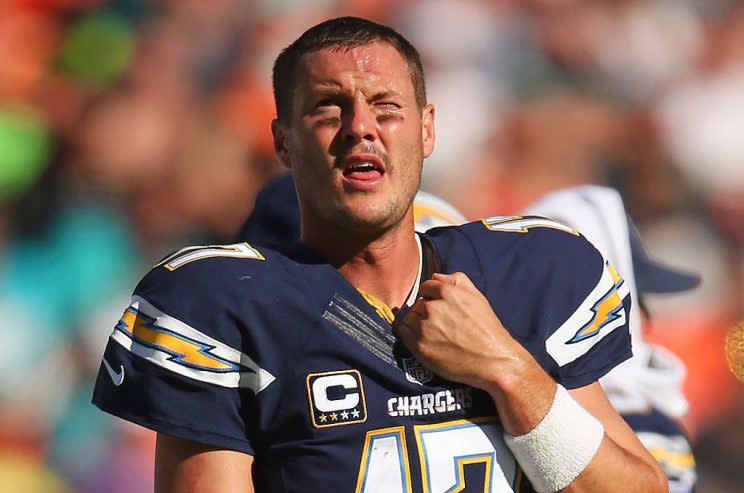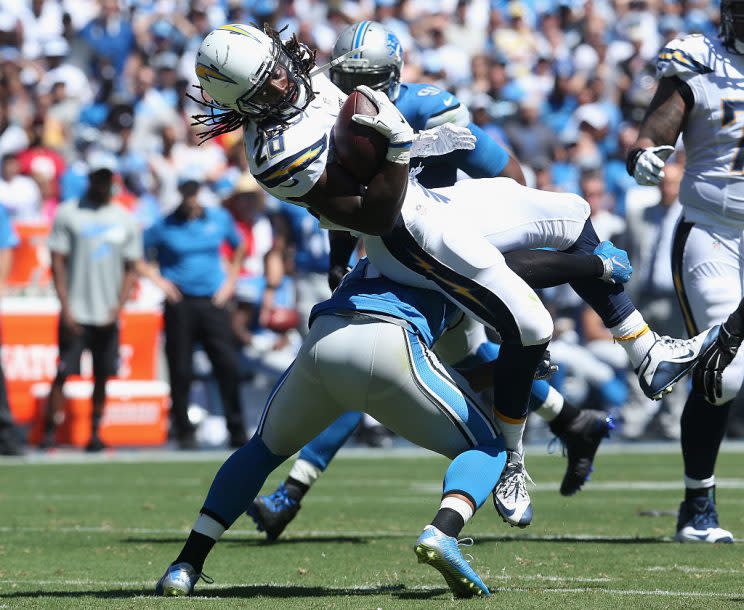Juggernaut Index, No. 23: The San Diego Chargers

The Juggernaut Index is our annual ranking and review of NFL teams for fantasy purposes — repeat: FANTASY PURPOSES. Here, we concern ourselves with a franchise’s likely contributions to the fantasy player pool. We are not concerned with projected wins and losses. Instead, we’re focused on yards and points. As always, we’re beginning with the league’s least useful teams, working our way toward the elite fantasy juggernauts.
[Yahoo Fantasy Football is open for the 2016 season. Sign up now!]
Over the past year, many things have gone wrong for the San Diego Chargers, in all phases. The team lost a dozen games last season, ranked next-to-last in the league in rushing, and the defense allowed 6.0 yards per play. And then the franchise nuked its relationship with Eric Weddle, one of the more accomplished players in team history. And the Bolts have been battling their home city, too.
It was really a big powder blue mess for the Chargers in 2015. But amid San Diego’s various missteps and failings, quarterback Philip Rivers delivered a heroic fantasy season. Rivers established new personal highs in pass attempts (661), completions (437) and passing yards (4792) last year, and he produced one of the lowest interception rates (2.0) of his career. He somehow made all these statistical gains during a year in which his receiving corps was again decimated by injuries. No Chargers skill player finished with more than Danny Woodhead’s 755 receiving yards last season, but seven different guys topped 400 yards. Rivers threw for at least 300 yards in eight games in 2015, and he tossed multiple TD passes ten times. All things considered, it was an excellent season for our purposes. No complaints.

This year, Rivers will be reunited with OC Ken Whisenhunt, the coach who helped revive his career back in 2013. In Whiz’s previous season in San Diego, his offense ranked fifth in total yardage, fourth in passing and tops in third-down conversion rate. Perhaps more importantly, Rivers posted a career-best passer rating of 105.5, he led the NFL in completion percentage (69.5), and his yards per attempt jumped from 6.8 to 8.2. So we can feel pretty good about this particular QB/OC partnership. Rivers should be universally drafted as a top-12 quarterback, and it wouldn’t be a surprise at all if he dramatically outperformed his ADP (95.6, QB11).
It would help Rivers’ cause in no small way to get a full season from fourth-year receiver Keenan Allen. At the halfway point in 2015, before Allen was sidelined by a lacerated kidney (reminder: football is full of terrors), he was on pace for a ridiculous 134 receptions and 1450 yards. He saw double-digit targets in five of his eight games and was a near-lock to finish with first-round value. Allen is now back to full strength and it’s clear he’s earned the trust of his quarterback…
Philip Rivers on Keenan Allen: “I really thought he figured out last year what it took to be a No. 1 WR in this league.” Allen back healthy.
— Michael Gehlken (@sdutGehlken) May 23, 2016
In PPR formats, Allen deserves consideration at or near the turn picks. If you can get him at the end of Round 2, it’s thievery.
Behind Allen, we find a collection of familiar and mostly uninteresting names in this team’s receiving hierarchy. Travis Benjamin signed a four-year, $24 million deal with the Bolts in March, coming off an unexpected breakout season (68-966-5). To me, Benjamin is a guy you want to own in best-ball leagues, not in traditional formats. He’s a boom/bust receiver in this offense, a stress-the-defense vertical threat. We can expect that a substantial percentage of his targets will involve throws of 20-plus yards; think of him as a smaller, quicker and younger Malcom Floyd. If you expect more from Benjamin than a 55-750-5 season, then you’re reaching.

Stevie Johnson remains in the mix for San Diego, but he’s entering his age-30 season and hasn’t really given us a healthy campaign since 2012. The Chargers basically always have three receivers and one tight end on the field, so snaps shouldn’t be an issue for Stevie when he’s healthy. He’s obviously not a player who needs to appear on cheat sheets for leagues of standard size, however.
Antonio Gates returns for his zillionth 14th NFL season, and he’s just a year removed from a top-three finish at his position. At 36, he remains a viable fantasy asset, thanks in large part to his rare rapport with Rivers. Gates averaged 57.3 yards per week last year, his best per-game output since 2011, and he returned from his early-season PED suspension with a 92-yard, two-TD performance against Pittsburgh. He’s ancient by NFL standards, sure, but he remains productive. San Diego used a second-round draft pick to select Gates’ eventual replacement, Hunter Henry, but there’s no reason to ever target rookie tight ends in any non-dynasty fantasy format. Henry was the top player at his position on pretty much all draft boards this year, so file away his name for later use. (Longtime fantasy tease Ladarius Green has relocated to Pittsburgh.)
San Diego’s running game last season was a civic embarrassment, a flaming disaster, an insult to the legacy of LaDainian Tomlinson, Natrone Means and Chuck Muncie. The Chargers’ O-line was a brutal run-blocking unit, lacking elite individual talent, and the group couldn’t stay healthy. Rookie first-round running back Melvin Gordon was an absolute mess, averaging just 3.5 yards per carry, losing four fumbles, and somehow failing to find the end-zone on any of his 217 touches.
That’s right: 217 touches, zero touchdowns. Not good.
Gordon’s many supporters — like this guy and this guy and Cap’n Huevos himself — will point to Melvin’s subscribers-only stats from last season (missed-tackle rate, for example) and conclude that he was secretly not terrible. Certainly his line did him no favors, but that group doesn’t look special in the year ahead, either. Gordon never hit 100 scrimmage yards in any game, and he only reached 80 three times. He was of course light on explosive plays last year — his longest run was 27 yards — and few analysts will claim that he’s an unusually instinctive or creative runner. Honestly, I find it impossible to repackage Gordon’s rookie season as anything but a complete bust, start to finish. And did we mention that he underwent a microfracture procedure in January? Well, he did.

Still, despite all the issues, I wouldn’t go so far as to declare that Gordon makes my list of players to avoid at any price. For one thing, I have no such list. Also, it’s not uncommon for backs to make significant leaps in their second pro seasons after adjusting to NFL game-speed. Gordon was a massively productive collegiate player at Wisconsin, so we know he isn’t physically incapable of crossing goal lines. His workload is secure in San Diego, given the state of the backfield depth chart and the organization’s investment in the player. It’s easy to imagine Gordon delivering, say, a top-24 positional finish; it’s almost impossible to imagine a top-10 season, because he showed us so alarmingly little last year. So if you want to draft Gordon at his current ADP (67.8, RB28), I won’t fault you. But if you want to brag about drafting him, you’re probably an idiot.
I suppose we shouldn’t treat Danny Woodhead as a footnote here, because he actually outscored Gordon by a huge margin last season in all fantasy formats. Woodhead gained 1091 scrimmage yards on 178 total touches and he broke the plane nine times, including a four-TD performance against Miami in Week 15. He also led all NFL running backs in targets (107), catches (81), receiving yards (756) and receiving TDs (6). Woodhead was actually less productive than Gordon on a per-carry basis last year (3.4 YPC), but he’s clearly a dangerous receiving weapon. He’s now 31 years old, however, and he won’t see many double-digit target games while Allen and Gates are both in the mix. Don’t draft Woodhead expecting last year’s numbers, is what I’m saying. Instead, think of him as a less electric Darren Sproles, with a much better QB.
San Diego’s defense was horrendous last season, ranking No. 28 in yards per pass attempt allowed (7.9) and No. 30 in yards per carry (4.8). They generated just 20 takeaways and 32 sacks, totals that ranked in the bottom-third of the NFL. First-round rookie Joey Bosa should help eventually, but this D doesn’t belong in the fantasy conversation, except as a group you’ll look to stream against.
—
2015 Offensive Stats & Ranks
Points per game – 20.0 (26)
Pass YPG – 286.9 (4)
Rush YPG – 84.9 (31)
Yards per play – 5.4 (18)
Plays per game – 68.8 (3)
—
Previous Juggernaut Index entries: 32) Cleveland, 31) San Francisco, 30) Philadelphia, 29) Baltimore, 28) Tennessee, 27) Los Angeles, 26) Miami, 25) Detroit, 24) Chicago, 23) San Diego

 Yahoo Sports
Yahoo Sports 

